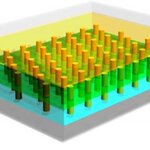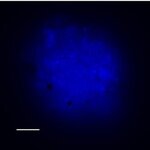Energy
Summertime, and the livin' is easy, wrote Ira Gershwin and Du Bose Heyward in 1933. The current gasoline prices are not easy on the budget because they are rising again. According to the New York Times of 8 June 2009: "Gas prices have risen 41 days in a row, to a national average of almost $2.62 a gallon. That is a sharp increase from the low of $1.62 a gallon that prevailed at the end of last year." Then, on 9 July 2009, again the New York Times: "Oil prices briefly fell under $60 a barrel on Thursday after nearly two weeks of uninterrupted declines, as traders and investors…

Researchers at Lawrence Berkeley National Lab and UC Berkeley say they have demonstrated a way to fabricate efficient solar cells from low-cost, flexible materials; optically active semiconductors in arrays of nanoscale pillars, each a single crystal, with dimensions measured in billionths of a meter.
A solar cell's basic job is to convert light energy into charge-carrying electrons and "holes" (the absence of an electron), which flow to electrodes to produce a current. Unlike a typical two-dimensional solar cell, a nanopillar array offers much more surface for collecting light.…

Sulfate gets all the attention but iron and manganese compounds may be important role in converting methane to carbon dioxide and eventually carbonates in the Earth's oceans, according to a team of researchers looking at anaerobic sediments.
Those same compounds may also have been key to methane reduction in the early, oxygenless days of the planet's atmosphere. On the early Earth, where oxygen was absent from the atmosphere, sulfates were scarce. Without sulfates, iron and manganese oxides may have been essential in converting methane to carbon dioxide.
Microbes or groups of microbes…

Stirling Energy Systems (SES) and Tessera Solar recently unveiled four newly designed solar power collection dishes at Sandia National Laboratories’ National Solar Thermal Test Facility (NSTTF).
Sandia’s concentrating solar-thermal power (CSP) team has been working closely with SES over the past five years to improve the system design and operation.
The modular CSP SunCatcher uses precision mirrors attached to a parabolic dish to focus the sun’s rays onto a receiver, which transmits the heat to a Stirling engine. The engine is a sealed system filled with hydrogen. As the gas heats and cools,…

lol. Once a oil man always a oil man. T.B. Pickens pulls the plug on his windmill scheme now supporting drilling for natural gas and oil. With over a million supporters of his energy plan based on wind energy he shuts it down and now endorses oil and gas. Imagine that? The problem was to be the infrastructure to deliver the electricity. The solution would be to make smaller wind farms right next to the grid. Can you say rocket science.

A new printable battery that can be produced cost-effectively on a large scale has been developed by a research team led by Prof. Dr. Reinhard Baumann of the Fraunhofer Research Institution for Electronic Nano Systems ENAS in Chemnitz together with colleagues from TU Chemnitz and Menippos GmbH.
Like your t-shirt, the batteries are printed using a silk-screen method.
They are also different from conventional batteries in that these printable versions weigh less than one gram, are less than a millimeter thick and can even be integrated into bank cards.
The battery contains no mercury…

As a kid, there were few things more satisfying to me that being given a helium balloon... and then almost immediately letting it go for the pure enjoyment of seeing it float out of sight into the sky. For some reason, seeing a small balloon set against a vast blue background gave me a small sense of power simply from knowing that I was the one that put it up there. A silly grin would spread across my face as I stared at the small dot in the sky, knowing that only a minute earlier I held that very same balloon in my own little hand. I felt like a small part of me was launched along with it,…

Its my opinion that the current economic conditions were brought on by high gas prices. I believe if we can consume less fuel we can stabilize the price of gasoline and our economy. If we do nothing we will have contributed to our failing economy. Here is a solution we can implement right now, saving money and improving our economy. I have doubled my gas mileage. If you have improved your mileage and want to share your designs or ideas please post. If you are an idiot and think it is impossible to improve gasoline mileage don't waste our time. Would you…

An international team of researchers has modified chlorophyll from an alga so that it resembles the extremely efficient light antennae of bacteria. The team was then able to determine the structure of these light antennae. This is the first step to converting sunlight into energy using an artificial leaf.
Leiden researcher Swapna Ganapathy has obtained her PhD based on this subject, under the supervision of Professor Huub de Groot, one of the initiators of the research.
Artificial forests at the nano- scale and highways where gaps in the surface are filled with pigment molecules that…

University of Georgia researchers have developed a successful way to grow molecular wire brushes that conduct electrical charges, a first step in developing biological fuel cells that could power pacemakers, cochlear implants and prosthetic limbs.
UGA chemist Jason Locklin and graduate students Nicholas Marshall and Kyle Sontag grew polymer brushes, made up of chains of thiophene and benzene, aromatic molecules sometimes used as solvents, attached to metal surfaces as ultra-thin films.
"The molecular wires are actually polymer chains that have been grown from a metal surface at very…